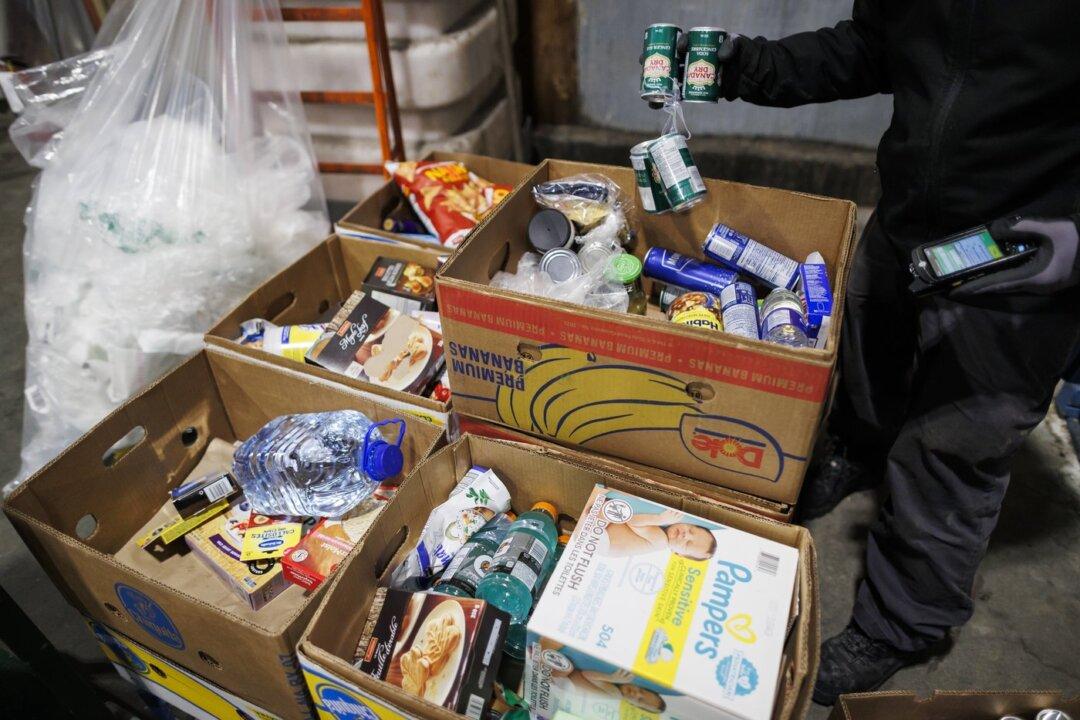Canada’s ongoing cost-of-living crisis has left food banks struggling with an increasing demand for their services and fewer donations, with some banks being forced to ration their dwindling supplies.
“We hate to reach a point where we have to give less food or serve fewer people, but that is definitely where we are at right now,” said Food Banks Alberta executive director Shawna Bissell.
“The surpluses and the reserves that we might have been able to accumulate are being used up very quickly, and it is impacting things like hamper size. We do the very best we can, but we definitely do have less to go around.”
Several negative economic factors—such as higher interest rates, increased food inflation and rental costs, and lower production—have combined to create a cost-of-living crisis for Canadians. Many have been forced to turn to food pantries, as shown by the
2023 report by Food Banks Canada which said usage has risen to its highest level since the survey began in 1989.
That troubling trend shows no sign of changing anytime soon. According to Second Harvest’s annual
“Hungry for Change” study, the demand for food banks across Canada is expected to increase by 18 percent in 2024. The food rescue organization also predicts there will be a $76,000 shortfall of funding per non-profit, and that 36 percent of them will be forced to turn hungry Canadians away.
Ms. Bissell told The Epoch Times that Alberta food banks have seen an uptick in the “working poor”—Canadians who have full-time jobs but are still struggling to get by—seeking their services.
“They’re just not bringing in enough money, with the cost of goods being what they are, to make ends meet,” she said.
Food Banks Alberta has seen a decline in food items contributions in recent years, necessitating buying the items directly. But the same food inflation impacting ordinary Canadians has hit the food bank. “Our dollar just doesn’t go as far when we’re purchasing those staple items, so affordability itself is definitely impacting us,” she said.
Growing Numbers Across Canada
Food bank usage has increased dramatically in virtually every region of Canada, leading to unsettling headlines like
50 military veterans in New Brunswick being forced to line up at one food bank, or a
Toronto Facebook group providing 10,000 members with
advice on dumpster diving to find food.
The Ottawa Food Bank saw a total of 493,951 visits in the 2022 to 2023 fiscal year—a 22 percent increase compared to the year prior and a “historic high in our 40-year history,” said communications and advocacy officer Alex Noreau.
She told The Epoch Times food purchasing expenses for the bank rose even more dramatically, costing 46 percent more than the year prior.
In Toronto, one in 10
people utilized a food bank in 2023, double the number of the previous year. According to the annual “Who’s Hungry?” report released last November, half of the clients were employed and nearly 60 percent had completed a post-secondary education.
In Alberta, more than 75,000 Edmontonians were served by food banks in 2023. Edmonton Food Bank manager of strategic relationships and partnerships Tamisan Bencz-Knight tried to give a sense of scale by noting that the city’s Commonwealth Stadium, the largest venue in Canada, holds just 56,000 people.
“And the challenge we have too is that we’re trying to share those numbers, but behind each one of those numbers is a person that we can’t forget,” she said. “It could be a neighbour, a family friend, it could be a colleague, a co-worker, a child at school.”
Ms. Bencz-Knight also noted the number of donations to the food bank has decreased, forcing it to buy food directly. The food bank prepared to “weather” a coming increase in demand in 2022 by reducing the size of its food hampers given out to each person, she added.
Ms. Bencz-Knight said while the Edmonton Food Bank is fortunate to have diversified funding sources, there are still concerns about how sustainable its operations will be if demand continues increasing.
“There is that question; how long can we operate with monthly deficits like this of food coming in?“ she said. ”Again, we’re very lucky that we have so many good community members that are still giving to us. We’re cautiously optimistic.”
‘Do What They Can’
Dan Huang-Taylor, executive director at Food Banks B.C., said the 107 different food banks across the province have reported a “very consistent story” of donations falling and demand for services rising over the last few years. He said there has been a 20 to 30 percent drop in donations, both from individual donors and corporations.
Many food banks have been forced to eat into their cash reserves to continue supporting people, Mr. Huang-Taylor said. “The last thing any food bank wants to do is compromise its ability to give people the food they need. They don’t want to run wait lists, they don’t want to reduce the amount of food or the volume of service.”
There has been a “deeply concerning” rise in the number of Canadians working one or two jobs that still need to visit food banks, as well as an increase in international students seeking help, according to Mr. Huang-Taylor. “We’ve been able to support a number of campus food banks that have spoken about the drastic increases in students who need to access this service, both domestic and international.”
Mr. Huang-Taylor said all levels of government need to come together to address the crisis.
But until those long-term solutions are put in place, Mr. Huang-Taylor said, food banks will continue to “do what they can to ensure people are getting an adequate amount of food.”






